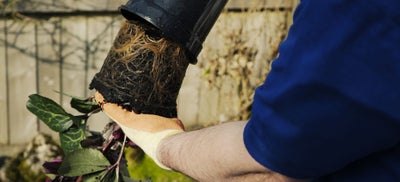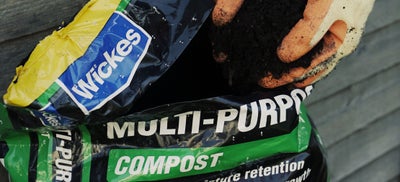Planting out in beds and borders
Planting your new bulbs and shrubs is pretty straightforward, but there’s a little more to it than just digging a hole. To ensure plants establish quickly, grow properly and live a long time, you need to follow a few simple guidelines.
Most plants that you buy from garden retailers have been grown in rich potting compost, not soil. So your planting hole needs to match these conditions to encourage the roots to spread out into the soil. This ensures your plant will get off to the best possible start and establish itself quickly.
Different plants or bulbs need to be planted out at different times, so it definitely helps to plan in advance. This means you can maximise the flowering season in your garden so it looks as good as possible for as long as possible.
Establishing new plants
Watering new plants is absolutely vital but it can be influenced by the type of soil you have. Heavy clay soil is more prone to waterlogging, so water infrequently and thoroughly. Lighter sandy or chalk soils are more porous and dry out quickly, so water lightly but frequently.
Mulching the area around your new plants and bulbs preserves soil moisture and helps regulate soil temperature. Mulch is also an effective natural weed control.
It’s best not to fertilise newly planted trees and shrubs for at least a year, preferably two. Excess fertilisation at this stage could actually reduce root growth but encourage top growth. Your tree then risks becoming top heavy and more likely to uproot and tip over.
For hints and tips on the huge variety of flowers, bulbs, trees and shrubs you can put in your garden, and the best time of year to plant them, read our Gardening Calendar guide.
How to plant bulbs
Bulbs such as daffodils, dahlias and snowdrops provide lovely bright displays, especially in spring or autumn when many other plants aren’t in flower. Bulbs are easy to plant and grow, and are a great way to give your garden some colour.
Most hardy bulbs such as tulips and daffodils prefer a warm sunny site with good drainage. But there are bulbs available which will thrive in cooler, damper soils. Plant your bulbs out as soon as possible after purchase – storing them for lengthy periods of time will result in poor flowering.
Try to plant a minimum of 25-30 bulbs, in groups of six, to ensure an impressive display.
Bulbs should be planted at two to three times their depth. For example, for a bulb measuring 5cm (2in) high, dig a hole 10cm (4in) deep and sit the bulb in the bottom of the hole.
If your soil is prone to waterlogging, place a layer of horticultural grit in the bottom of the hole.
Place the bulbs in the hole with their ‘nose’ or ‘shoot’ facing upwards. Space them at least twice a bulb’s width apart.
Backfill the soil and gently tamp down with your hand, or the back of a trowel or rake. Avoid treading on the soil as this will damage the bulbs. If the ground is already moist or the bulbs are planted in the autumn there’s no need to water after planting.
Planting a pot grown plant
Water the plant thoroughly before you start so that the compost and the roots are soaked.
Dig a hole at least 10cm (4in) deeper and wider than the pot the plant is currently growing in. Make sure the hole is free from weeds and existing root systems.
Enrich the soil you’ve dug out with some planting compost or organic material. This is your planting mixture. Then place some of the planting mixture in the bottom of the hole.
Carefully remove the plant from its pot. For trees and larger shrubs it might be easier to cut the pot on two sides to release the plant. Never try to remove a plant by tugging at the stem or trunk. Then gently tease out some of the roots from the root ball, and place the plant in the hole, making sure it’s upright and the root crown is level with the garden soil.
Backfill with the rest of the planting mixture, gently pressing down as you go to make sure there are no air pockets. With your new plant in position, tamp down the soil with your hands or the back of a trowel. For larger shrubs and trees you can tread the soil down.
Water the plant well, then add some mulch or decorative bark to the area.
Planting a bare root tree or shrub
Place the tree or shrub into some water for at least an hour before planting. This prevents the roots from drying out. Remove any damaged or ‘turned in’ roots before planting with some pruning shears. This is important as cleanly cut roots will heal a lot quicker than torn roots.
Dig an appropriately sized hole. Most trees need a wide, shallow hole as their roots will spread outwards not downwards.
Follow the same technique that was used for shrubs, by creating a planting mixture from the displaced soil and some compost or other organic material such as manure. Position the plant in the hole and start adding the planting mixture. Use your hands to gradually work the mixture between the roots. Then backfill with the rest of the planting mixture so the roots are completely covered. Tread the soil down firmly and carefully with your heel.
The purpose of staking a new tree is to stop the root ball moving, not to prevent the tree swaying about in the wind, so staking should be limited and only used if necessary. Drive a 4ft long stake into the ground at a 45 degree angle near and low to the trunk.
Secure the stake to the trunk with rubber strapping, making sure that stake and trunk aren’t rubbing against each other. Inspect regularly to ensure that it’s not damaging the bark. Except for very windy sites, all staking should be removed after one year.
Water the tree well and add some mulch to the area.

















